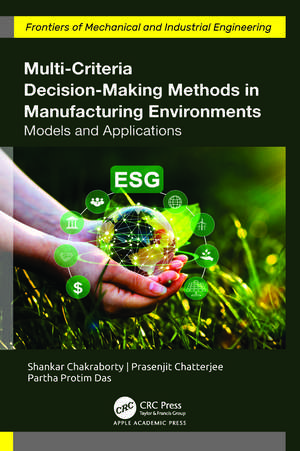Multi-Criteria Decision-Making Methods in Manufacturing Environments: Models and Applications: Frontiers of Mechanical and Industrial Engineering
Autor Shankar Chakraborty, Prasenjit Chatterjee, Partha Protim Dasen Limba Engleză Hardback – 13 oct 2023
Preț: 840.64 lei
Preț vechi: 1123.51 lei
-25% Nou
Puncte Express: 1261
Preț estimativ în valută:
160.86€ • 175.28$ • 135.54£
160.86€ • 175.28$ • 135.54£
Carte tipărită la comandă
Livrare economică 23 aprilie-07 mai
Preluare comenzi: 021 569.72.76
Specificații
ISBN-13: 9781774912614
ISBN-10: 1774912619
Pagini: 450
Ilustrații: 213 Tables, black and white; 17 Line drawings, color; 18 Line drawings, black and white; 17 Illustrations, color; 18 Illustrations, black and white
Dimensiuni: 156 x 234 mm
Greutate: 0.99 kg
Ediția:1
Editura: Apple Academic Press Inc.
Colecția Apple Academic Press
Seria Frontiers of Mechanical and Industrial Engineering
ISBN-10: 1774912619
Pagini: 450
Ilustrații: 213 Tables, black and white; 17 Line drawings, color; 18 Line drawings, black and white; 17 Illustrations, color; 18 Illustrations, black and white
Dimensiuni: 156 x 234 mm
Greutate: 0.99 kg
Ediția:1
Editura: Apple Academic Press Inc.
Colecția Apple Academic Press
Seria Frontiers of Mechanical and Industrial Engineering
Public țintă
PostgraduateCuprins
Part I: An introduction to Multi-criteria Decision-Making 1. Introduction Part II: MCDM Methods and their Applications 2. Analytic Hierarchy Process (AHP) 3. Analytic Network Process (ANP) 4. Weighted Aggregated Sum Product Assessment (WASPAS) Method 5. Multi-Objective Optimization on the Basis of Ratio Analysis (MOORA) 6. Technique for Order of Preference by Similarity to Ideal Solution (TOPSIS) 7. VIekriterijumsko KOmpromisno Rangiranje (VIKOR) 8. ELimination Et Choice Translating REality (ELECTRE) 9. Preference Ranking Organization METHod for Enrichment Evaluation (PROMETHEE) 10. COmplex PRoportional ASsessment (COPRAS) Method 11. Organization, Rangement Et Synthese De Donnes RElationnelles (ORESTE) Method 12. Operational Competitiveness Rating Analysis (OCRA) Method 13. Additive Ratio ASsessment (ARAS) Method 14. Evaluation Based on Distance from Average Solution (EDAS) Method 15. COmbinative Distance-Based ASsessment (CODAS) Method 16. EVAluation of MIXed Data (EVAMIX) Method 17. Preference Selection Index (PSI) Method 18. TOmada de Decisao Interativa Multicriterio (TODIM) Method 19. Range of Value (ROV) Method 20. Superiority and Inferiority Ranking (SIR) Method 21. Measuring Attractiveness by a Categorical-Based Evaluation TecHnique (MACBETH) 22. Modified Similarity Index Method 23. Multi-Attributive Border Approximation Area Comparison (MABAC) Method 24. Multi-Attributive Real-Ideal Comparative Analysis (MARICA) Method 25. Measurement Alternatives and Ranking according to COmpromise Solution (MARCOS) Method 26. COmbined COmpromise SOlution (CoCoSo) Method 27. Ranking of Alternatives through Functional mapping of criterion sub-intervals into a Single Interval (RAFSI) Method 28. Simultaneous Evaluation of Criteria and Alternatives (SECA) Method 29. R Method 30. Compromise Ranking of Alternatives from Distance to Ideal Solution (CRADIS) Method Part III: Normalization in MCDM 31. Normalization Techniques Part IV: Criteria Weight Measurement Techniques 32. Criteria Weight Measurement Techniques
Notă biografică
Shankar Chakraborty, PhD, is Professor in the Department of Production Engineering at Jadavpur University, India. He has published more than 200 research papers in international journals. He is an Associate Editor of the journal OPSEARCH and is an editorial board member of several journals. He is also a regular reviewer for numerous international and national journals. His research interest includes multi-criteria decision-making, operations research, and soft computing techniques.
Prasenjit Chatterjee, PhD, is Dean (Research and Consultancy) at the MCKV Institute of Engineering, West Bengal, India. He is a prolific author and editor on the topics of intelligent decision-making, supply chain management, optimization techniques, risk, and sustainability modeling. He has received numerous awards for his work. Dr. Chatterjee is the Editor-in-Chief of the Journal of Decision Analytics and Intelligent Computing and is the Series Editor of the several book series. He is one of the developers of two multiple-criteria decision-making methods, called Measurement of Alternatives and Ranking according to COmpromise Solution (MARCOS) and Ranking of Alternatives through Functional mapping of criterion sub-intervals into a Single Interval (RAFSI).
Partha Protim Das, PhD, is Assistant Professor in the Department of Mechanical Engineering of Sikkim Manipal Institute of Technology, Sikkim Manipal University, India. He has published many research papers in international journals. He is also a regular reviewer for several national and international journals. His research interests include decision-making, soft computing techniques, optimization, artificial intelligence techniques, machining processes, etc.
Prasenjit Chatterjee, PhD, is Dean (Research and Consultancy) at the MCKV Institute of Engineering, West Bengal, India. He is a prolific author and editor on the topics of intelligent decision-making, supply chain management, optimization techniques, risk, and sustainability modeling. He has received numerous awards for his work. Dr. Chatterjee is the Editor-in-Chief of the Journal of Decision Analytics and Intelligent Computing and is the Series Editor of the several book series. He is one of the developers of two multiple-criteria decision-making methods, called Measurement of Alternatives and Ranking according to COmpromise Solution (MARCOS) and Ranking of Alternatives through Functional mapping of criterion sub-intervals into a Single Interval (RAFSI).
Partha Protim Das, PhD, is Assistant Professor in the Department of Mechanical Engineering of Sikkim Manipal Institute of Technology, Sikkim Manipal University, India. He has published many research papers in international journals. He is also a regular reviewer for several national and international journals. His research interests include decision-making, soft computing techniques, optimization, artificial intelligence techniques, machining processes, etc.
Descriere
Introduces MCDM methods starting from problem formulation, model development, criteria weighting, and alternative scoring and then to the ranking of alternatives. The authors explain the step-by-step processes of different MCDM methods for specific manufacturing environments, which allows readers to perceive the presented methodologies.



